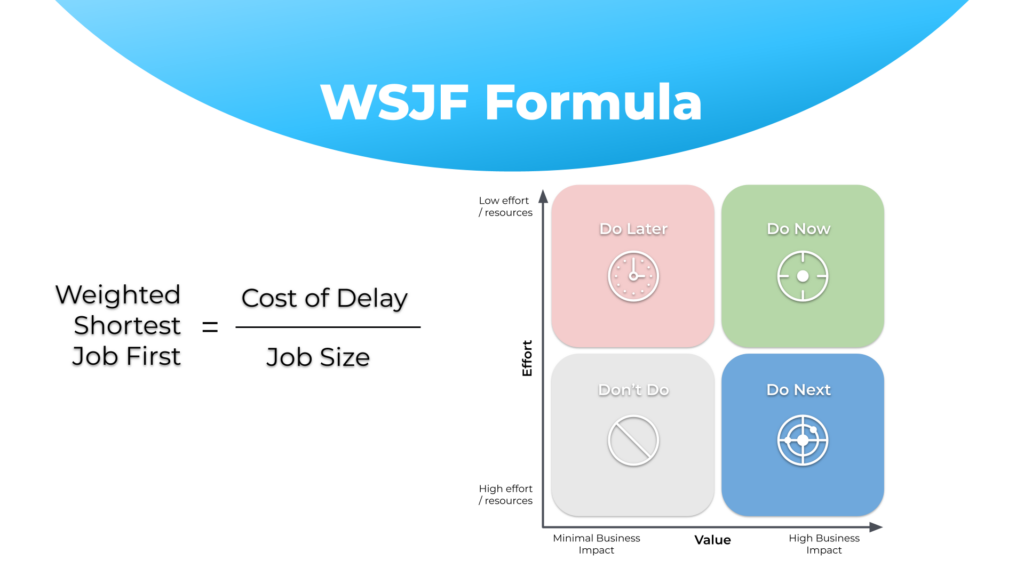
WSJF: Prioritizing the PMM Backlog
What is it?
Weighted Shortest Job First (WSJF) originates in the Scaled Agile Framework (SAFe) as an economic prioritization method that sequences engineering work by Cost of Delay ÷ Job Size. Generally speaking, the calculation gives preference to jobs with shorter duration relative to the highest impact on the business.
what does that have to do with Product Marketing?
As we all know, cross-functional teams have competing priorities that can create conflicting deliverables when time & collaboration resources are thin. Product Marketers can use the same lean-economics logic to sequence jobs tied to key company outcomes—revenue acceleration, pipeline velocity, retention, and risk reduction/opportunity enablement. Instead of “features,” the PMM delivers prioritized, qualifiable artifacts: positioning and messaging, segment POVs, launch plans, enablement assets, competitive plays, pricing/packaging experiments, analyst briefs, and market tests.
How Does It Work in Practice?
Cross-functional negotiation with Product, Sales, CS, and RevOps clarifies value, time-criticality, and RR/OE, while job size anchors effort. In team meetings, we discuss different initiatives and evaluate the Cost of Delay relative to business goals, and the resulting calculation provides a metric-defined & team-negotiated prioritization. The result is a transparent, defensible queue where the highest economic impact per unit of effort ships first.

Cost of Delay (CoD)
| Component | Guiding Questions | |||
|---|---|---|---|---|
| User & Business Value (BV) | Relative value to the customer or business | They prefer this over that | Revenue impact | Potential penalty or other negative impact |
| Time Criticality (TC) | How user or business value decays over time | Is there a fixed deadline? | Will they wait for us or move to another solution? | What is the current effect on customer satisfaction? |
| Risk Reduction & Opportunity Enablement (RR/OE) | What else does this do for our business? | Does it reduce risk for this or future delivery? | Is there value in the information we will receive? | Does it enable new business opportunities? |
Job Size
This can be negotiated and determined by the cross-functional team in its charter, based on resources and preferred cadence. Each Fibonacci value represents a level of effort that the task will take. A simplified version:
- 1 = one hour
- 3 = one day
- 5 = three days
- 8 = one week
- 13 = two weeks
- 21 = one month
Example:
Product needs a customer-facing Product Roadmap, Sales needs a Whitepaper, and Marketing needs a Product Demo Video. For simplicity’s sake, we’ll assume the teams has discussed the relative* Cost of Delay Fibonacci values in cross-functional team meeting.
- The Product Roadmap has a high business value, moderate time criticality, and a moderate risk/opportunity factor
- The Whitepaper is low business value, low time criticality, and low risk/opportunity
- The Demo Video is moderate business value, low time criticality, and moderate risk / opportunity
*Relative to the other deliverables
| Deliverable | Job Size | Cost of Delay | WSJF |
|---|---|---|---|
| Product Roadmap | 3 (one day) | 13 + 8 + 8 = 22 | 7.3 |
| Whitepaper | 8 (one week) | 3 + 1 + 3 = 7 | .8 |
| Demo Video | 13 (one month) | 8 + 3 + 13 = 24 | 1.8 |
Based on the WSJF values, the Product Roadmap should be at the top of the queue; followed by the Demo Video. And the White Paper should pushed to the next PMM sprint, and be evaluated as a possible eliminated project.
Calculator
| Backlog Item | BV | TC | RR/OE | JS | CoD | WSJF | Actions |
|---|
